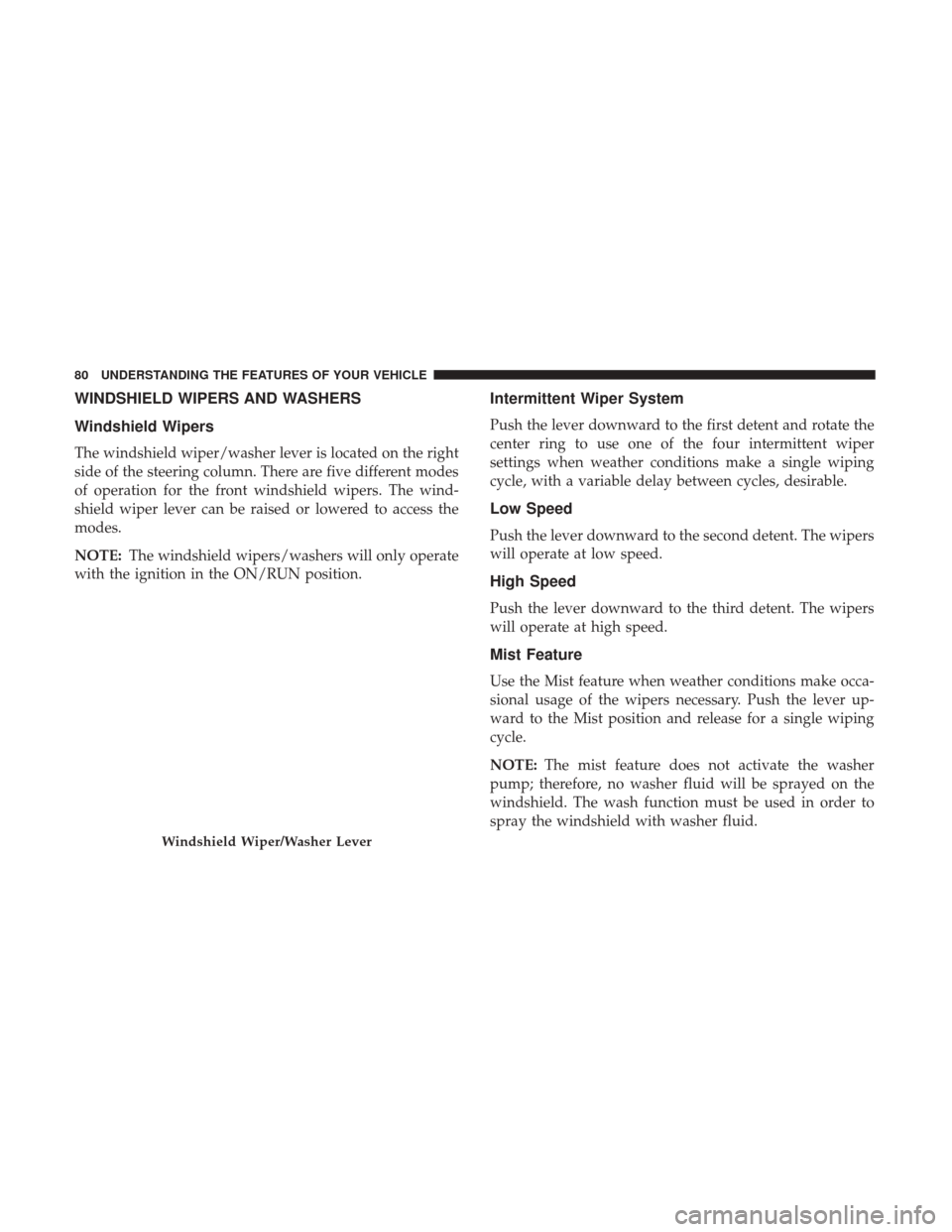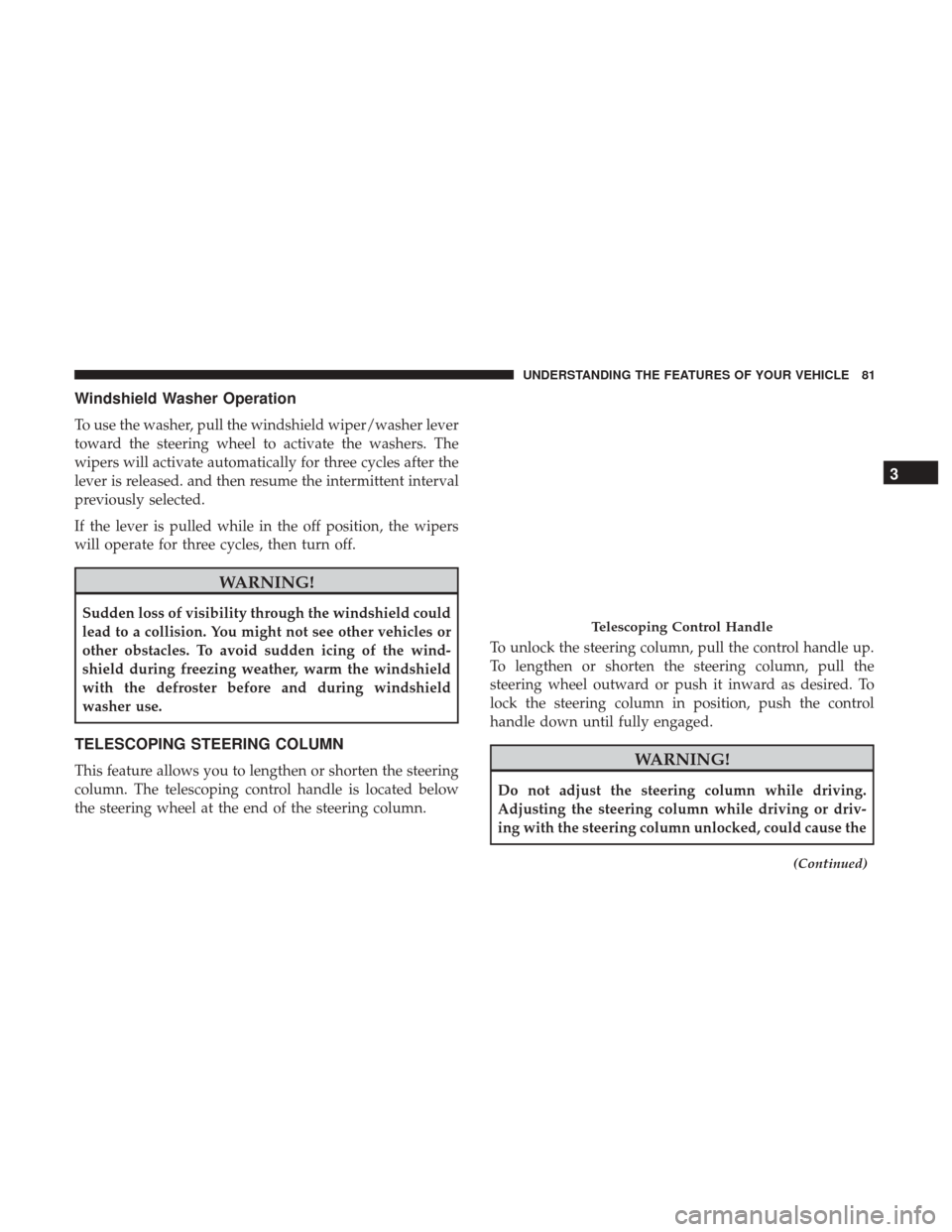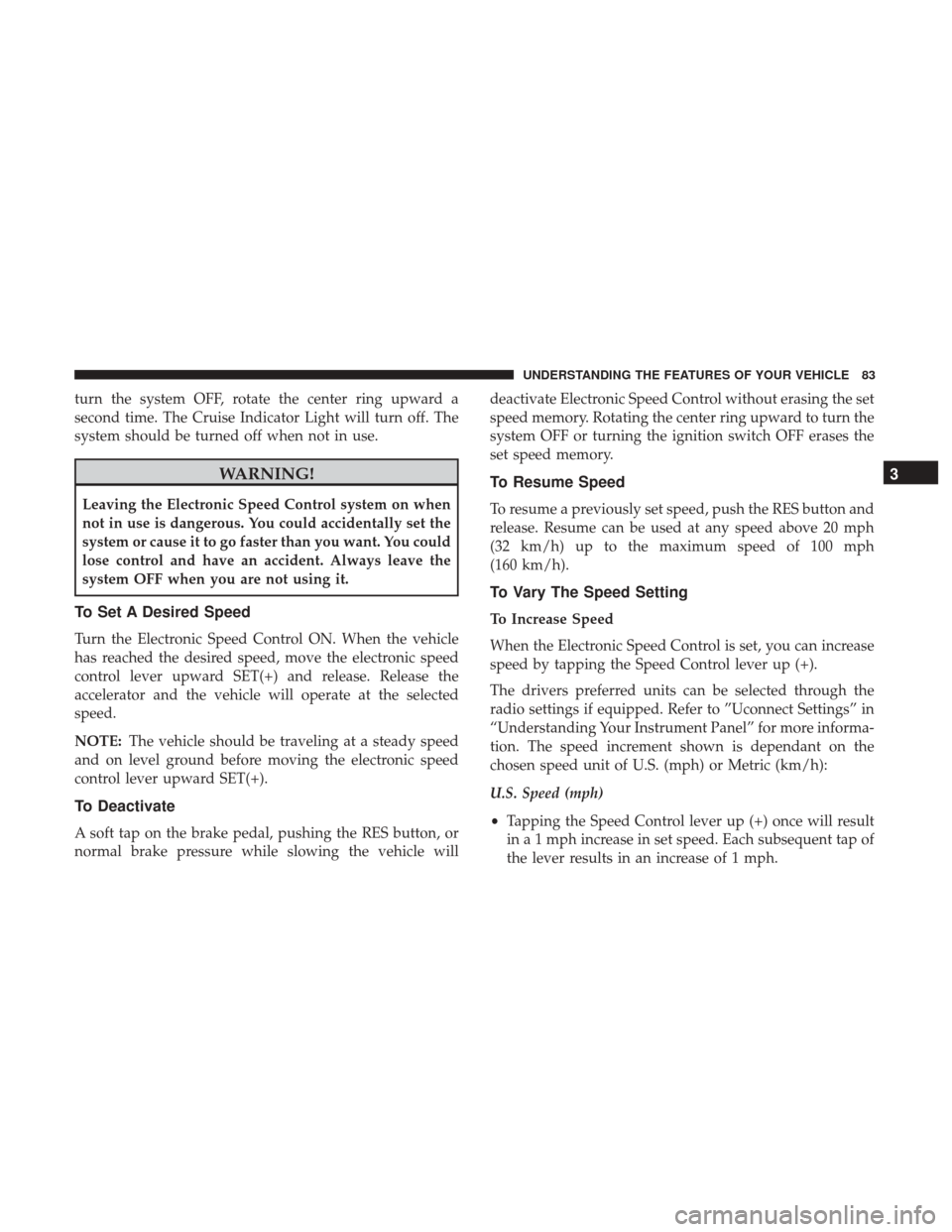Ram ProMaster 2017 Manual Online
Manufacturer: RAM, Model Year: 2017, Model line: ProMaster, Model: Ram ProMaster 2017Pages: 348, PDF Size: 3.04 MB
Page 81 of 348

Your vehicle may be equipped with a Side Cargo Lamp
located at the upper rear area of the passenger side sliding
door opening.The Cargo Lamps can be set to three different positions
(Off/Right Position, Center Position, On/Left Position).
•
Push the Cargo Lamp lens to the right from its center
position and the lamp is always off.
• Leave the Cargo Lamp lens in the center position, and
the lamp is turned on and off when the sliding doors or
rear doors are opened or closed.
• Push the Cargo Lamp lens to the left from its center
position and the lamp is always on.
Side Cargo Lamp
3
UNDERSTANDING THE FEATURES OF YOUR VEHICLE 79
Page 82 of 348

WINDSHIELD WIPERS AND WASHERS
Windshield Wipers
The windshield wiper/washer lever is located on the right
side of the steering column. There are five different modes
of operation for the front windshield wipers. The wind-
shield wiper lever can be raised or lowered to access the
modes.
NOTE:The windshield wipers/washers will only operate
with the ignition in the ON/RUN position.
Intermittent Wiper System
Push the lever downward to the first detent and rotate the
center ring to use one of the four intermittent wiper
settings when weather conditions make a single wiping
cycle, with a variable delay between cycles, desirable.
Low Speed
Push the lever downward to the second detent. The wipers
will operate at low speed.
High Speed
Push the lever downward to the third detent. The wipers
will operate at high speed.
Mist Feature
Use the Mist feature when weather conditions make occa-
sional usage of the wipers necessary. Push the lever up-
ward to the Mist position and release for a single wiping
cycle.
NOTE: The mist feature does not activate the washer
pump; therefore, no washer fluid will be sprayed on the
windshield. The wash function must be used in order to
spray the windshield with washer fluid.
Windshield Wiper/Washer Lever
80 UNDERSTANDING THE FEATURES OF YOUR VEHICLE
Page 83 of 348

Windshield Washer Operation
To use the washer, pull the windshield wiper/washer lever
toward the steering wheel to activate the washers. The
wipers will activate automatically for three cycles after the
lever is released. and then resume the intermittent interval
previously selected.
If the lever is pulled while in the off position, the wipers
will operate for three cycles, then turn off.
WARNING!
Sudden loss of visibility through the windshield could
lead to a collision. You might not see other vehicles or
other obstacles. To avoid sudden icing of the wind-
shield during freezing weather, warm the windshield
with the defroster before and during windshield
washer use.
TELESCOPING STEERING COLUMN
This feature allows you to lengthen or shorten the steering
column. The telescoping control handle is located below
the steering wheel at the end of the steering column.To unlock the steering column, pull the control handle up.
To lengthen or shorten the steering column, pull the
steering wheel outward or push it inward as desired. To
lock the steering column in position, push the control
handle down until fully engaged.WARNING!
Do not adjust the steering column while driving.
Adjusting the steering column while driving or driv-
ing with the steering column unlocked, could cause the
(Continued)
Telescoping Control Handle
3
UNDERSTANDING THE FEATURES OF YOUR VEHICLE 81
Page 84 of 348

WARNING!(Continued)
driver to lose control of the vehicle. Failure to follow
this warning may result in serious injury or death.
ELECTRONIC SPEED CONTROL
When engaged, the Electronic Speed Control takes over
accelerator operations at speeds greater than 25 mph
(40 km/h) up to the maximum speed of 100 mph
(160 km/h).
The Electronic Speed Control Lever is located on the left
side of the steering column.
NOTE:In order to ensure proper operation, the Electronic
Speed Control System has been designed to shut down if
multiple Speed Control functions are operated at the same
time. If this occurs, the Electronic Speed Control System
can be reactivated by rotating the Electronic Speed Control
ON/OFF center ring and resetting the desired vehicle set
speed.
To Activate
Rotate the center ring upward on the electronic speed
control lever to turn the system ON. The Cruise Indicator
Light in the Instrument Cluster Display will illuminate. To
Electronic Speed Control Lever
82 UNDERSTANDING THE FEATURES OF YOUR VEHICLE
Page 85 of 348

turn the system OFF, rotate the center ring upward a
second time. The Cruise Indicator Light will turn off. The
system should be turned off when not in use.
WARNING!
Leaving the Electronic Speed Control system on when
not in use is dangerous. You could accidentally set the
system or cause it to go faster than you want. You could
lose control and have an accident. Always leave the
system OFF when you are not using it.
To Set A Desired Speed
Turn the Electronic Speed Control ON. When the vehicle
has reached the desired speed, move the electronic speed
control lever upward SET(+) and release. Release the
accelerator and the vehicle will operate at the selected
speed.
NOTE:The vehicle should be traveling at a steady speed
and on level ground before moving the electronic speed
control lever upward SET(+).
To Deactivate
A soft tap on the brake pedal, pushing the RES button, or
normal brake pressure while slowing the vehicle will deactivate Electronic Speed Control without erasing the set
speed memory. Rotating the center ring upward to turn the
system OFF or turning the ignition switch OFF erases the
set speed memory.
To Resume Speed
To resume a previously set speed, push the RES button and
release. Resume can be used at any speed above 20 mph
(32 km/h) up to the maximum speed of 100 mph
(160 km/h).
To Vary The Speed Setting
To Increase Speed
When the Electronic Speed Control is set, you can increase
speed by tapping the Speed Control lever up (+).
The drivers preferred units can be selected through the
radio settings if equipped. Refer to ”Uconnect Settings” in
“Understanding Your Instrument Panel” for more informa-
tion. The speed increment shown is dependant on the
chosen speed unit of U.S. (mph) or Metric (km/h):
U.S. Speed (mph)
•
Tapping the Speed Control lever up (+) once will result
in a 1 mph increase in set speed. Each subsequent tap of
the lever results in an increase of 1 mph.
3
UNDERSTANDING THE FEATURES OF YOUR VEHICLE 83
Page 86 of 348

•If the lever is continually held up, the set speed will
continue to increase until the lever is released, then the
new set speed will be established.
Metric Speed (km/h)
• Tapping the Speed Control lever up (+) once will result
in a 1 km/h increase in set speed. Each subsequent tap
of the lever results in an increase of 1 km/h.
• If the lever is continually held up, the set speed will
continue to increase until the lever is released, then the
new set speed will be established.
To Decrease Speed
When the Electronic Speed Control is set, you can decrease
speed by tapping the Speed Control lever down (-).
The drivers preferred units can be selected through the
radio settings if equipped. Refer to ”Uconnect Settings” in
“Understanding Your Instrument Panel” for more informa-
tion. The speed increment shown is dependant on the
chosen speed unit of U.S. (mph) or Metric (km/h):
U.S. Speed (mph)
• Tapping the Speed Control lever down (-) once will
result in a 1 mph decrease in set speed. Each subsequent
tap of the lever results in a decrease of 1 mph. •
If the lever is continually held down, the set speed will
continue to decrease until the lever is released, then the
new set speed will be established.
Metric Speed (km/h)
• Tapping the Speed Control lever down (-) once will
result in a 1 km/h decrease in set speed. Each subse-
quent tap of the lever results in a decrease of 1 km/h.
• If the lever is continually held down, the set speed will
continue to decrease until the lever is released, then the
new set speed will be established.
To Accelerate For Passing
Press the accelerator as you would normally. When the
pedal is released, the vehicle will return to the set speed.
Using Electronic Speed Control On Hills
The transmission may downshift on hills to maintain the
vehicle set speed.
NOTE: The Electronic Speed Control system maintains
speed up and down hills. A slight speed change on
moderate hills is normal.
84 UNDERSTANDING THE FEATURES OF YOUR VEHICLE
Page 87 of 348

On steep hills, a greater speed loss or gain may occur so it
may be preferable to drive without Electronic Speed Con-
trol.
WARNING!
Electronic Speed Control can be dangerous where the
system cannot maintain a constant speed. Your vehicle
could go too fast for the conditions, and you could lose
control and have an accident. Do not use Electronic
Speed Control in heavy traffic or on roads that are
winding, icy, snow-covered or slippery.
PARKSENSE REAR PARK ASSIST — IF EQUIPPED
The ParkSense Rear Park Assist system provides an au-
dible indication of the distance between the rear fascia/
bumper and a detected obstacle when backing up, e.g.
during a parking maneuver. Refer to ParkSense System
Usage Precautions for limitations of this system and rec-
ommendations.The ParkSense Rear Park Assist is automatically activated
when the transmission is placed into REVERSE. As the
distance from an obstacle behind the vehicle decreases, the
audible alert becomes more frequent.
Interaction With Trailer Towing
The Rear Park Assist system is automatically deactivated
when a trailer is hitched to the vehicle. The system will be
automatically activated as soon as the trailer is removed.
ParkSense Rear Park Assist Sensors
The four ParkSense Rear Park Assist sensors, located in the
rear fascia/bumper, monitor the area behind the vehicle
that is within the sensors’ field of view. The sensors can
detect obstacles, in the horizontal direction, from approxi-
mately 12 inches (30 cm) up to 55 inches (140 cm) from the
center of the rear fascia/bumper and up to 24 inches
3
UNDERSTANDING THE FEATURES OF YOUR VEHICLE 85
Page 88 of 348

(60 cm) from the corners of the rear fascia/bumper, de-
pending on the location, type and orientation of the
obstacle.
If several obstacles are detected, the ParkSense Rear Park
Assist system indicates the nearest obstacle.The minimum height of a detectable obstacle corresponds
to the maximum height of an obstacle that would clear the
underside of the vehicle during the parking maneuver.
ParkSense Rear Park Assist Alerts
If an obstacle is behind the vehicle when REVERSE gear is
engaged, an audible alert is activated.
The tones emitted by the loudspeaker inform the driver
that the vehicle is approaching an obstacle. The pauses
between the tones are directly proportional to the distance
from the obstacle. Pulses emitted in quick succession
indicate the presence of a very close obstacle. A continuous
tone indicates that the obstacle is less than 12 inches
(30 cm) away.
Rear Park Assist Sensors Location
86 UNDERSTANDING THE FEATURES OF YOUR VEHICLE
Page 89 of 348

Audible And Visual Signals Supplied By The ParkSense Rear Park Assist System
SIGNALMEANINGINDICATION
Obstacle Distance An obstacle is present within the
sensors’ field of view Audible signal
(dashboard loud-
speaker)
• Sound pulses emitted at a rate that
increases as the distance decreases.
• Emits continuous tone at 12 inches
(30 cm).
• Adjustable volume level program-
mable through personal settings in
the Instrument Cluster Display. Refer
to “Instrument Cluster Display” in
“Understanding Your Instrument
Panel”.
Failure Sensor or System failures Visual Signal(instrument panel)
• Icon appears on display.
• Message is displayed on multifunc-
tion display (where provided).
While audible signals are emitted, the audio system is not
muted.
The audible signal is turned off immediately if the distance
increases. The tone cycle remains constant if the distance
measured by the inner sensors is constant. If this condition occurs for the external sensors, the signal is turned off after
three seconds (stopping warnings during maneuvers par-
allel to walls).
3
UNDERSTANDING THE FEATURES OF YOUR VEHICLE 87
Page 90 of 348

ParkSense Rear Park Assist Failure Indications
A malfunction of the ParkSense Rear Park Assist sensors or
system is indicated, during REVERSE gear engagement, by
the instrument panel warning icon.The warning icon is illuminated and a message is
displayed on the multifunction display (if
equipped). Refer to “Instrument Cluster Descrip-
tions” in “Understanding Your Instrument
Panel” for further information.
The sensors and wiring are tested continuously when the
ignition is in the ON/RUN position. Failures are indicated
immediately if they occur when the system is ON.
Even if the system is able to identify that a specific sensor
is in failure condition, the Instrument Cluster Display shall
indicate that the ParkSense Rear Park Assist system is
unavailable, without reference to the sensor in failure
condition. If even a single sensor fails, the entire system
must be disabled. The system is turned off automatically.
Cleaning The ParkSense Rear Park Assist System
Clean the ParkSense Rear Park Assist sensors with water,
car wash soap and a soft cloth. Do not use rough or hard
cloths. In washing stations, clean sensors quickly keeping
the vapor jet/high pressure washing nozzles at least 4 inches (10 cm) from the sensors. Do not scratch or poke
the sensors. Otherwise, you could damage the sensors.
ParkSense Rear Park Assist System Usage
Precautions
NOTE:
•
Ensure that the outer surface and the underside of the
rear bumper is clean and clear of snow, ice, mud, dirt or
other obstruction to keep the Rear Park Assist system
operating properly.
• Jackhammers, large trucks, and other vibrations could
affect the performance of Rear Park Assist.
• Clean the Rear Park Assist sensors regularly, taking care
not to scratch or damage them. The sensors must not be
covered with ice, snow, slush, mud, dirt or debris.
Failure to do so can result in the system not working
properly. The Rear Park Assist system might not detect
an obstacle behind the fascia/bumper, or it could pro-
vide a false indication that an obstacle is behind the
fascia/bumper.
• Objects such as bicycle carriers, etc., must not be placed
within 12 inches (30 cm) from the rear fascia/bumper
while driving the vehicle. Failure to do so can result in
88 UNDERSTANDING THE FEATURES OF YOUR VEHICLE